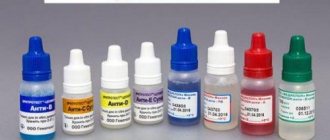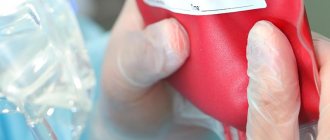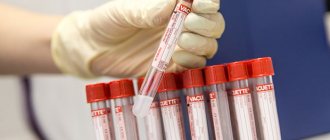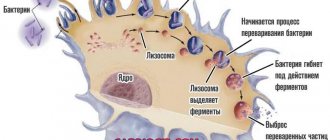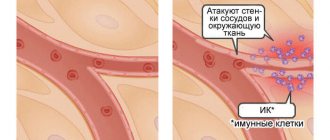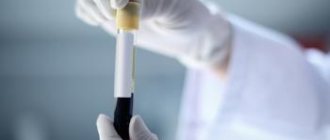October 22, 2012
There are eight blood types, which are determined by the presence or absence of certain antigens. Why is it necessary to know yours?
Different people have approximately the same blood composition: it contains the same basic elements. However, there are eight types of blood
, which are determined by the presence or absence of certain antigens.
These substances can cause a reaction from the immune system if they are foreign to it. Blood is divided into four groups according to the type of antigens
, as well as into two large groups
according to the presence of the Rh factor
.
How were blood groups discovered?
Experiments with transfusions of blood or its components have been carried out for hundreds of years.
For some, this treatment saved their lives, but most patients died after the transfusion. The reasons for this remained unknown until 1901, when the Austrian physician Karl Landsteiner discovered differences between blood samples from different people. How to become a donor?
Who can become a donor, how safe is it and how to prepare for blood donation? The answers to these and other questions are in the article on blood donation.
Thus, during experiments, Landsteiner noticed that in some cases mixing the blood of two patients can lead to agglutination - the clumping of red blood cells.
It turned out that it is this process that leads to fatal consequences. As it turned out, incompatibility of blood from different people is caused by the response of the immune system. If the recipient has antibodies against donated blood cells, the immune system tries to get rid of the foreign cells. The work of Karl Landsteiner made it possible to identify four blood groups and make blood transfusions safe
. For this discovery, the scientist was awarded the Nobel Prize in Physiology or Medicine in 1930.
Interesting Facts
As already mentioned, there are 2 types of blood - positive or negative. The most common option is the first. 2 positive blood group, the characteristics of which will be presented below, is present in a larger number of the population around the world.
It is noted that this type of blood appeared only after the 1st. Some suggest that this is related to the development of humanity. Primitive people were able to eat carbohydrates. They began to engage in gathering and farming. During this, the 2nd blood group was formed.
If you briefly describe people with this “substance”, you will notice that they are sociable and flexible. In addition, they tend to idealize the world. People with blood type 2 are excellent organizers.
What are blood groups?
The difference between the blood of different people lies in the presence or absence of certain protein molecules
called
antigens
.
They are located on the surface of red blood cells, erythrocytes and in the blood serum. It is these proteins that are responsible for the immune system’s reaction to “foreign” blood. The combinations of these molecules vary from person to person. They depend on the genetic information that people inherit from their parents. The blood group is determined by the presence or absence of two antigens A and B on the surface of red blood cells and antibodies to them in the blood plasma. In Russia, it is usually customary to name blood groups by numbers
: first, second, third and fourth.
In international practice, the designation of blood group follows the AB0
: 0 - First group, A - second group, B - third group, AB - fourth group.
- The first (0) blood group has antibodies A and B only in the blood plasma.
- The second (A) group has antigen A on the surface of red blood cells and antibodies B in the blood plasma.
- The third (B) group has antigen A in the blood plasma and antibodies B on the surface of red blood cells.
- The fourth (AB) group has A and B antigens on the surface of red blood cells.
Compatibility tests
During blood transfusion, the following tests are performed:
- An individual compatibility test is carried out by mixing the recipient's serum and donor's blood in a special test tube. The result is assessed by the presence or absence of agglutination, manifested in the formation of sediment in the form of flakes;
- The Rh factor compatibility test is carried out by mixing a drop of donor blood and two drops of recipient serum. If there is agglutination, the blood is not compatible;
- A biological test is carried out just before the transfusion by administering 10-15 ml of donor blood and observing the patient for three minutes for signs of incompatibility. At the same time, the color of the skin, urine, pulse, temperature and blood pressure are assessed.
Agglutination is a sign of incompatibility
Rh factor
In addition to antigens A and B, many people also have the so-called Rh factor on the surface of their red blood cells. This is also an antigen that is shared by 85 percent of Europeans and 99 percent of Asians. Such people are called Rh positive or RH+
.
Those who do not have the Rh factor in their blood are called Rh negative or RH-
. If blood is transfused from a person with a negative Rh factor to a person with a positive Rh factor, no problems arise. Otherwise, Rh antibodies begin to be produced in the recipient’s blood, which lead to the destruction of red blood cells. Taking into account the presence of the Rh factor, a total of eight blood groups are obtained: 0 Rh+, 0Rh-, A Rh+, A Rh-, B Rh+, B Rh-, AB Rh+, AB Rh-.
Character traits
The sedentism of ancient people required the acquisition of communication skills. Those who survived were those who knew how to negotiate with the neighboring tribe, with whom it was pleasant to work together. Probably, in those days they also thought about justice.
Among all group characteristics, the following traits are typical for the second group: decency towards relatives and neighbors, a tendency to do work together, care for loved ones, and empathy.
They often cede leadership to others, but this does not mean that they themselves consider themselves unworthy. On the contrary, they dream of a high destiny, carefully hiding it. Such restlessness leads to internal stress and is harmful to health.
When choosing a profession, you should take into account your inclinations and not try to break the properties given by nature. Holders of the second group will be excellent teachers, doctors, and social workers. They have irreplaceable abilities in working with personnel and can successfully help in an election campaign.
Any commander needs experienced commissars
What if you mix blood from different groups?
If the blood types of the donor and recipient are incompatible, agglutination
- the sticking together of red blood cells due to the interaction of antigens. This process occurs if, for example, a person with blood type B receives the blood of a person with blood type A. Agglutinated red blood cells clog the blood vessels and stop blood circulation. This process resembles the formation of blood clots, although it is caused by other reasons. In addition, “broken” red blood cells lose hemoglobin, which, once outside the cell, becomes toxic. This can lead to fatal consequences.
Blood type diet: expert opinion
Is it worth trying the blood type diet? Commented by Tatyana Shapovalenko, chief physician of the Treatment and Rehabilitation Center of the Russian Ministry of Health.
Health Risk
Proponents of the theory that health depends on blood type believe that for A(II), attention should be paid to the following factors:
- decreased immunity, which easily occurs due to stress, infectious diseases, physical activity, and nutritional disorders;
- tendency to thrombosis, increased blood clotting;
- decreased acidity of gastric juice, impaired absorption of proteins and fats.
Such features can be deciphered as a tendency to the occurrence of such problems:
- diseases of the cardiovascular system;
- allergic manifestations, autoallergic diseases (rheumatoid polyarthritis, lupus, hepatitis, psoriasis);
- exposure to food infections, gastritis, pancreatitis;
- risk of malignant tumors.
Compatibility of different blood groups
Despite the difference in antigen content, in some cases, blood transfusion from a donor to a recipient with different blood groups is possible. The transfusion will be safe if the recipient does not have antibodies to the donor antigens. Thus, people with blood group 0 Rh-
are considered universal donors, since they do not have antigens or the Rh factor on the surface of their red blood cells.
AB Rh+
blood group are considered universal recipients, since their blood plasma does not contain a single antibody to the antigen and contains the Rh factor.
Complications
When incompatible blood is transfused, severe complications develop - transfusion shock, and later acute renal failure occurs. Their treatment is difficult and lengthy, and the prognosis may be unfavorable.
No one is immune from blood transfusion. Trauma, internal or external bleeding, complication of gastric ulcer and other acute conditions accompanied by blood loss. All of them require immediate replenishment of the main liquid tissue of our body.
It is also important to know the group and Rh factor for future parents in order to anticipate possible complications during a planned pregnancy.
When can Rh conflict occur?
It is possible only in one case - if the mother’s Rh factor is negative, the father’s is positive, and the fetus has inherited the father’s Rh factor.
The conflict arises due to the incompatibility of the mother's Rh-negative blood and the red blood cells of the unborn child, on the membranes of which there is a specific protein. When fetal red blood cells enter a woman’s bloodstream, her body perceives them as foreign and begins to produce antibodies against them.
As a rule, during the first pregnancy the amount of antibodies in the blood is small, so they do not affect the developing fetus. In addition, during the first pregnancy, the red blood cells of the unborn baby should not normally enter the mother’s blood, since this is prevented by the blood-placental barrier. Fetal blood enters a woman's bloodstream only during natural childbirth or during a caesarean section.
However, in some cases, it is possible for fetal red blood cells to reach the mother, including:
- Abortion.
- Ectopic pregnancy.
- Miscarriage.
- Taking amniotic fluid for analysis to diagnose fetal pathologies.
- Chorionic villus biopsy is the taking of its villi for analysis to diagnose fetal diseases.
- Bleeding during pregnancy.
- Rh+ blood transfusion.
When a child’s red blood cells come into contact with the mother’s blood, her body begins the process of producing Rh antibodies, which is called sensitization. If none of this has happened to a woman, most likely there will be no conflict during her first pregnancy, and the contact between the blood of mother and child, which occurs during the first birth, does not affect the health of the latter in any way. But if sensitization occurred for the above reasons or during the first birth, then this is irreversible. In subsequent pregnancies, treatment is necessary to prevent Rh conflict.
Diet
If people with the second blood group adhere to a proper diet, the risk of developing many pathologies that arise in them due to predisposition will decrease. The diet must include the maximum amount of healthy foods containing vitamins, trace elements, and minerals.
They also provide a list of products that are contraindicated for patients. They can harm internal organs and cause allergic reactions. The restrictions especially apply to people with chronic inflammatory diseases of the digestive tract and obesity.
Healthy foods
If the patient has a second positive blood group, it is recommended to eat less meat. His digestive tract is more predisposed to vegetables and fruits. When eating vegetables, the following positive qualities arise:
- stimulation of the digestive tract due to the intake of large amounts of fiber and organic acids;
- supply of large amounts of microelements, minerals and vitamins that stimulate metabolism.
It is recommended to eat vegetables after heat treatment. But some of them can be used raw. For example, tomatoes and cucumbers.
For representatives of the second blood group, the following types of vegetables bring greater effect:
- cucumbers, carrots, bell peppers;
- broccoli, potatoes, tomatoes;
- eggplants, white cabbage.
People with blood type 2 are recommended to eat large amounts of fruits and berries. But overly acidic foods are not recommended, otherwise they will increase the acidity of the stomach, which will provoke an increase in digestive pathologies.
If a person wants to eat meat, it is recommended to choose a lean type. For example, veal, turkey, chicken, rabbit. It is advisable to boil, steam, stew. You can't fry, it increases cholesterol.
Fish is very useful. It saturates the human body with Omega fatty acids and vitamin D. But excessively fatty varieties, which cause heaviness in the stomach and difficult digestion, are not recommended.
To improve the function of the gastrointestinal tract, it is recommended to consume cereals 3-4 times a week:
- millet, pearl barley, rice;
- barley, buckwheat porridge.
You can enhance digestion with different types of vegetable oils. Among them, sesame or linseed oil is of particular importance. Legumes, such as beans, are useful. But they can be used only in the absence of increased gas formation. Recommended drinks include freshly squeezed juice, tea, and fruit compote.
Harmful products
Fatty meats are not recommended, as they aggravate the digestion process and make it difficult:
- pork;
- mutton;
- duck;
- fatty and tough beef.
Fatty fish are not recommended. For example, halibut, mackerel. Due to the excessive acidity of the stomach contents, fruits with sour properties are excluded. Citrus fruits are excluded from them. For example, grapefruit, lemon.
Dairy products, especially fatty ones, complicate the digestion process and increase stomach acidity. They can cause increased gas formation and heaviness in the stomach. However, in high concentrations it is allowed to use only hard cheese and natural yogurt.
Various types of seasonings are excluded:
- ketchup, tomato paste, red sauce;
- mustard, horseradish, mayonnaise.
Marinades and canned foods are not recommended. Significantly reduce the amount of consumption of baked goods, chocolate, sweets, and cakes.
It is necessary to reduce the amount of alcohol consumption to a minimum. It is advisable to eliminate it completely. Also reduce the amount of coffee.

